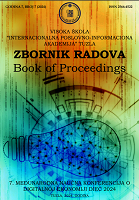THE STRUCTURE OF PARTICIPANTS IN HALF-YEAR EDUCATION PROGRAMS COMPARED WITH STUDENTS IN HIGHER PROFESSIONAL PROGRAMS AT THE FACULTY OF INFORMATION STUDIES AND RELATED STUDY PROGRAMS IN SLOVENIA AND EUROPE
THE STRUCTURE OF PARTICIPANTS IN HALF-YEAR EDUCATION PROGRAMS COMPARED WITH STUDENTS IN HIGHER PROFESSIONAL PROGRAMS AT THE FACULTY OF INFORMATION STUDIES AND RELATED STUDY PROGRAMS IN SLOVENIA AND EUROPE
Author(s): Nuša Erman, Nika Robida, Katarina RojkoSubject(s): Higher Education , ICT Information and Communications Technologies, Sociology of Education
Published by: Internacionalna poslovno – informaciona akademija
Keywords: Lifelong Learning; Tertiary Education; Informatics And Computer Science; Demographic Diversity; Trends In Education;
Summary/Abstract: Rapid technological development changes labour market needs, requiring lifelong learning - the constant upgrading of employees’ skills and knowledge. One of the goals of the European Commission under the Recovery and Resilience Plan is therefore also the adaptation of the tertiary education system. As part of these efforts, pilot projects in higher education are being funded in Slovenia, offering shorter forms of education, and within Faculty of Information Studies in Novo Mesto offers half-year education programs in the fields of informatics and computer science. Since this is a new form of education, we compared the structure of participants in these half-year programs with the structure of 1st Bologna cycle professional study program students at the faculty based on enrolment data. We found that women predominate among the participants in the half-year programs, which differs from the situation in study programs, where males constitute the majority of enrolled students. Participants in the half-year programs are also, on average, significantly older than the students at the faculty. Additionally, we compared these data with data for Slovenia and Europe. It is evident that interest in education in the fields of information and communication technologies is increasing. Moreover, women’s interest in this area of education is slowly growing, although this is still a male-dominated field, on which students of the younger age group mainly enrol. These findings highlight the need to adapt the education system to different groups of learners to become more responsive to labour market needs and enable greater inclusion of more heterogeneous social groups.
Journal: Zbornik radova Međunarodne naučne konferencije o digitalnoj ekonomiji DIEC
- Issue Year: 7/2024
- Issue No: 7
- Page Range: 121-137
- Page Count: 17
- Language: English

